High-Frequency Microbarograph-Observed Pressure Variations Associated with Gust Fronts during an Extreme Rainfall Event
Abstract
1. Introduction
2. Materials and Methods
3. Results
3.1. Overview of the Short-Lived Extreme Rainfall
3.2. Radar Analysis on the Mesoscale Boundaries and Associated Storms
4. Discussion
5. Conclusions
Author Contributions
Funding
Data Availability Statement
Acknowledgments
Conflicts of Interest
References
- Huang, S.; Li, Z.; Bao, C. Heavy Rainfall over Southern China in the Pre-Summer Rainy Season; Guangdong Science and Technology Press: Guangdong, China, 1996; p. 230. (In Chinese) [Google Scholar]
- Luo, Y.; Xia, R.; Chan, J. Characteristics, Physical Mechanisms, and Prediction of Pre-summer Rainfall over South China: Research Progress during 2008-2019. J. Meteorol. Soc. Jpn. Ser. II 2020, 98, 19–42. [Google Scholar] [CrossRef]
- Sun, J.; Zhang, Y.; Liu, R.; Fu, S.; Tian, F. A Review of Research on Warm-Sector Heavy Rainfall in China. Adv. Atmos. Sci. 2019, 36, 1299–1307. [Google Scholar] [CrossRef]
- Wang, H.; Luo, Y.; Jou, B.J.-D. Initiation, maintenance, and properties of convection in an extreme rainfall event during SCMREX: Observational analysis. J. Geophys. Res. Atmos. 2014, 119, 13–206. [Google Scholar] [CrossRef]
- Wu, M.; Luo, Y. Mesoscale observational analysis of lifting mechanism of a warm-sector convective system producing the maximal daily precipitation in China mainland during pre-summer rainy season of 2015. J. Meteorol. Res. 2016, 30, 719–736. [Google Scholar] [CrossRef]
- Lu, H.; Chen, S.; Guo, Y.; He, H.; Chen, S. Spatial-Temporal Variation Characteristics of Extremely Heavy Precipitation Frequency over Southern China in the Last 50 Years. J. Trop. Meteorol. 2012, 28, 219–227. [Google Scholar] [CrossRef]
- Wu, N.; Zhuang, X.; Min, J.; Meng, Z. Practical and Intrinsic Predictability of a Warm-Sector Torrential Rainfall Event in the South China Monsoon Region. J. Geophys. Res. Atmos. 2020, 125, e2019JD031313. [Google Scholar] [CrossRef]
- Jiang, Z.; Zhang, D.L.; Xia, R.; Qian, T. Diurnal Variations of Pre-Summer Rainfall over Southern China. J. Clim. 2017, 30, 755–773. [Google Scholar] [CrossRef]
- Wu, M.; Luo, Y.; Chen, F.; Wong, W.K. Observed Link of Extreme Hourly Precipitation Changes to Urbanization over Coastal South China. J. Appl. Meteorol. Climatol. 2019, 58, 1799–1819. [Google Scholar] [CrossRef]
- Du, Y.; Chen, G. Heavy Rainfall Associated with Double Low-Level Jets over Southern China. Part I: Ensemble-Based Analysis. Mon. Weather Rev. 2018, 146, 3827–3844. [Google Scholar] [CrossRef]
- Du, Y.; Chen, G. Heavy Rainfall Associated with Double Low-Level Jets over Southern China. Part II: Convection Initiation. Mon. Weather Rev. 2019, 147, 543–565. [Google Scholar] [CrossRef]
- Chen, X.; Zhang, F.; Zhao, K. Influence of Monsoonal Wind Speed and Moisture Content on Intensity and Diurnal Variations of the Mei-Yu Season Coastal Rainfall over South China. J. Atmos. Sci. 2017, 74, 2835–2856. [Google Scholar] [CrossRef]
- Du, Y.; Chen, G.; Han, B.; Mai, C.; Bai, L.; Li, M. Convection Initiation and Growth at the Coast of South China. Part I: Effect of the Marine Boundary Layer Jet. Mon. Weather Rev. 2020, 148, 3847–3869. [Google Scholar] [CrossRef]
- Du, Y.; Chen, G.; Han, B.; Bai, L.; Li, M. Convection Initiation and Growth at the Coast of South China. Part II: Effects of the Terrain, Coastline, and Cold Pools. Mon. Weather Rev. 2020, 148, 3871–3892. [Google Scholar] [CrossRef]
- Luo, Y.; Wu, M.; Ren, F.; Li, J.; Wong, W.-K. Synoptic Situations of Extreme Hourly Precipitation over China. J. Clim. 2016, 29, 8703–8719. [Google Scholar] [CrossRef]
- Johns, R.H.; Doswell, C.A. Severe Local Storms Forecasting. Weather Forecast. 1992, 7, 588–612. [Google Scholar] [CrossRef]
- Liu, X.; Luo, Y.; Guan, Z.; Zhang, D.-L. An Extreme Rainfall Event in Coastal South China During SCMREX-2014: Formation and Roles of Rainband and Echo Trainings. J. Geophys. Res. Atmos. 2018, 123, 9256–9278. [Google Scholar] [CrossRef]
- Huang, Y.; Liu, Y.; Liu, Y.; Li, H.; Knievel, J.C. Mechanisms for a Record-Breaking Rainfall in the Coastal Metropolitan City of Guangzhou, China: Observation Analysis and Nested Very Large Eddy Simulation with the WRF Model. J. Geophys. Res. Atmos. 2019, 124, 1370–1391. [Google Scholar] [CrossRef]
- Zhang, S.; Liang, Z.; Wang, D.; Chen, G. Nocturnal Convection Initiation over Inland South China during a Record-Breaking Heavy Rainfall Event. Mon. Weather Rev. 2022, 150, 2935–2957. [Google Scholar] [CrossRef]
- Droegemeier, K.K.; Wilhelmson, R.B. Three-Dimensional Numerical Modeling of Convection Produced by Interacting Thunderstorm Outflows. Part I: Control Simulation and Low-Level Moisture Variations. J. Atmos. Sci. 1985, 42, 2381–2403. [Google Scholar] [CrossRef]
- Wilson, J.W.; Schreiber, W.E. Initiation of Convective Storms at Radar-Observed Boundary-Layer Convergence Lines. Mon. Weather Rev. 1986, 114, 2516–2536. [Google Scholar] [CrossRef]
- Carbone, R.E.; Conway, J.W.; Crook, N.A.; Moncrieff, M.W. The Generation and Propagation of a Nocturnal Squall Line. Part I: Observations and Implications for Mesoscale Predictability. Mon. Weather Rev. 1990, 118, 26–49. [Google Scholar] [CrossRef][Green Version]
- Weiss, C.C.; Bluestein, H.B. Airborne Pseudo–Dual Doppler Analysis of a Dryline–Outflow Boundary Intersection. Mon. Weather Rev. 2002, 130, 1207–1226. [Google Scholar] [CrossRef]
- Wilson, J.W.; Roberts, R.D. Summary of Convective Storm Initiation and Evolution during IHOP: Observational and Modeling Perspective. Mon. Weather Rev. 2006, 134, 23–47. [Google Scholar] [CrossRef]
- Wakimoto, R.M.; Murphey, H.V. Analysis of Convergence Boundaries Observed during IHOP_2002. Mon. Weather Rev. 2010, 138, 2737–2760. [Google Scholar] [CrossRef]
- Mai, C.; Du, Y.; Li, M. Processes of Colliding Cold Pools Derived from a 356-m-High Shenzhen Met-Tower during an Extremely Heavy Rainfall Event. Mon. Weather Rev. 2023, 151, 1571–1585. [Google Scholar] [CrossRef]
- Purdom, J.F.W.; Marcus, K. Thunderstorm trigger mechanisms over the southeast United States. In Proceedings of the 12th Conference on Severe Local Storms of the American Meteorological Society, San Antonio, TX, USA, 12–15 January 1982; American Meteorological Society: Boston, MA, USA; pp. 487–488. [Google Scholar]
- Weckwerth, T.M.; Wakimoto, R.M. The Initiation and Organization of Convective Cells atop a Cold-Air Outflow Boundary. Mon. Weather Rev. 1992, 120, 2169–2187. [Google Scholar] [CrossRef]
- Kingsmill, D.E. Convection Initiation Associated with a Sea-Breeze Front, a Gust Front, and Their Collision. Mon. Weather Rev. 1995, 123, 2913–2933. [Google Scholar] [CrossRef]
- Fankhauser, J.C.; Crook, N.A.; Tuttle, J.; Miller, L.J.; Wade, C.G. Initiation of Deep Convection along Boundary Layer Convergence Lines in a Semitropical Environment. Mon. Weather Rev. 1995, 123, 291–314. [Google Scholar] [CrossRef]
- Bai, L.; Meng, Z.; Huang, Y.; Zhang, Y.; Niu, S.; Su, T. Convection Initiation Resulting from the Interaction Between a Quasi-Stationary Dryline and Intersecting Gust Fronts: A Case Study. J. Geophys. Res. Atmos. 2019, 124, 2379–2396. [Google Scholar] [CrossRef]
- Harrison, S.J.; Mecikalski, J.R.; Knupp, K.R. Analysis of Outflow Boundary Collisions in North-Central Alabama. Weather Forecast. 2009, 24, 1680–1690. [Google Scholar] [CrossRef]
- Karan, H.; Knupp, K. Radar and Profiler Analysis of Colliding Boundaries: A Case Study. Mon. Weather Rev. 2009, 137, 2203–2222. [Google Scholar] [CrossRef]
- Haghi, K.R.; Geerts, B.; Chipilski, H.G.; Johnson, A.; Degelia, S.; Imy, D.; Parsons, D.B.; Adams-Selin, R.D.; Turner, D.D.; Wang, X. Bore-ing into Nocturnal Convection. Bull. Am. Meteorol. Soc. 2019, 100, 1103–1121. [Google Scholar] [CrossRef]
- Zhang, S.; Parsons, D.B.; Wang, Y. Wave Disturbances and Their Role in the Maintenance, Structure, and Evolution of a Mesoscale Convection System. J. Atmos. Sci. 2020, 77, 51–77. [Google Scholar] [CrossRef]
- Zhang, S.; Parsons, D.B.; Xu, X.; Wang, Y.; Liu, J.; Abulikemu, A.; Shen, W.; Zhang, X.; Zhang, S. A modeling study of an atmospheric bore associated with a nocturnal convective system over China. J. Geophys. Res. Atmos. 2020, 125, e2019JD032279. [Google Scholar] [CrossRef]
- Zhang, S.; Parsons, D.B.; Xu, X.; Sun, J.; Wu, T.; Xu, F.; Na, W.; Chen, G. Bores observed during the warm season of 2015–2019 over the southern North China Plain. Geophys. Res. Lett. 2022, 49, e2022GL099205. [Google Scholar] [CrossRef]
- Crook, N.A. Trapping of Low-Level Internal Gravity Waves. J. Atmos. Sci. 1988, 45, 1533–1541. [Google Scholar] [CrossRef]
- Rottman, J.W.; Simpson, J.E. The formation of internal bores in the atmosphere: A laboratory model. Q. J. R. Meteorol. Soc. 1989, 115, 941–963. [Google Scholar] [CrossRef]
- Haghi, K.R.; Durran, D.R. On the Dynamics of Atmospheric Bores. J. Atmos. Sci. 2021, 78, 313–327. [Google Scholar] [CrossRef]
- Geerts, B.; Parsons, D.; Ziegler, C.L.; Weckwerth, T.M.; Biggerstaff, M.I.; Clark, R.D.; Coniglio, M.C.; Demoz, B.B.; Ferrare, R.A.; Gallus, W.A.; et al. The 2015 Plains Elevated Convection at Night Field Project. Bull. Am. Meteorol. Soc. 2017, 98, 767–786. [Google Scholar] [CrossRef]
- Loveless, D.M.; Wagner, T.J.; Turner, D.D.; Ackerman, S.A.; Feltz, W.F. A Composite Perspective on Bore Passages during the PECAN Campaign. Mon. Weather Rev. 2019, 147, 1395–1413. [Google Scholar] [CrossRef]
- Parsons, D.B.; Haghi, K.R.; Halbert, K.T.; Elmer, B.; Wang, J. The Potential Role of Atmospheric Bores and Gravity Waves in the Initiation and Maintenance of Nocturnal Convection over the Southern Great Plains. J. Atmos. Sci. 2019, 76, 43–68. [Google Scholar] [CrossRef]
- Knupp, K. Observational Analysis of a Gust Front to Bore to Solitary Wave Transition within an Evolving Nocturnal Boundary Layer. J. Atmos. Sci. 2006, 63, 2016–2035. [Google Scholar] [CrossRef]
- Koch, S.E.; Feltz, W.; Fabry, F.; Pagowski, M.; Geerts, B.; Bedka, K.M.; Miller, D.O.; Wilson, J.W. Turbulent Mixing Processes in Atmospheric Bores and Solitary Waves Deduced from Profiling Systems and Numerical Simulation. Mon. Weather Rev. 2008, 136, 1373–1400. [Google Scholar] [CrossRef][Green Version]
- Haghi, K.R.; Parsons, D.B.; Shapiro, A. Bores Observed during IHOP_2002: The Relationship of Bores to the Nocturnal Environment. Mon. Weather Rev. 2017, 145, 3929–3946. [Google Scholar] [CrossRef]
- Blake, B.T.; Parsons, D.B.; Haghi, K.R.; Castleberry, S.G. The Structure, Evolution, and Dynamics of a Nocturnal Convective System Simulated Using the WRF-ARW Model. Mon. Weather Rev. 2017, 145, 3179–3201. [Google Scholar] [CrossRef]
- Kortschinski, J.; Murty, R.C.; Curry, M.J. Microbarograph for meteorological studies: Design, theory and analysis. J. Phys. E Sci. Instrum. 1971, 4, 307. [Google Scholar] [CrossRef]
- Balachandran, N.K. Gravity Waves from Thunderstorms. Mon. Weather Rev. 1980, 108, 804–816. [Google Scholar] [CrossRef][Green Version]
- Nappo, C.J.; Crawford, T.L.; Eckman, R.M.; Auble, D.L. A high-precision sensitive electronic microbarograph network. In Proceedings of the Seventh Symposium on Meteorological Observations and Instrumentation, New Orleans, LA, USA, 13–18 January 1991; American Meteorological Society: Boston, MA, USA; pp. J179–J181. [Google Scholar][Green Version]
- Anderson, P.; Mobbs, S.; King, J.; McConnell, I.; Rees, J. A microbarograph for internal gravity wave studies in Antarctica. Antarct. Sci. 1992, 4, 241–248. [Google Scholar] [CrossRef]
- Li, Q.; Li, S.; Zhao, C. A Study of Array Detection of Atmospheric Gravity Waves on Severe Hailstorm Process. Guizhou Geol. 2001, 18, 73–78. (In Chinese) [Google Scholar] [CrossRef]
- Wang, X.; Lei, H.; Feng, L.; Zhu, J.; Li, Z.; Jiang, Z. Analysis of the characteristics of gravity waves during a local rainstorm event in Foshan, China. Atmos. Ocean. Sci. Lett. 2020, 13, 163–170. [Google Scholar] [CrossRef]
- Wang, X.; Ran, L.; Qi, Y.; Ma, S.; Mu, X.; Jiang, Z.; Bi, X. Analysis of characteristics gravity waves of heavy rainfall event based on microbarograph observation. Acta Phys. Sin. 2021, 70, 271–283. [Google Scholar] [CrossRef]
- Zhang, J.; Li, Z.; Huang, X. The Analysis Between Foshan Heavy Precipitation and Pre-Signal of Sliding Discrete Power Spectrum on Micromanometer. Adv. Meteorol. Sci. Technol. 2020, 10, 86–89. (In Chinese) [Google Scholar] [CrossRef]
- Skamarock, W.C.; Klemp, J.B.; Dudhia, J.; Gill, D.O.; Barker, D.; Duda, M.G.; Huang, X.Y.; Wang, W.; Powers, J.G. A Description of the Advanced Research WRF Version 3; (No. NCAR/TN-475+STR, 113 pp.); University Corporation for Atmospheric Research: Boulder, CO, USA, 2008. [Google Scholar] [CrossRef]
- Hong, S.-Y.; Dudhia, J.; Chen, S.-H. A Revised Approach to Ice Microphysical Processes for the Bulk Parameterization of Clouds and Precipitation. Mon. Weather Rev. 2004, 132, 103–120. [Google Scholar] [CrossRef]
- Janjic, Z.I. The surface layer in the NCEP eta model. In Proceedings of the 11th Conference on Numerical Weather Prediction, Norfolk, VA, USA, 19–23 August 1996; pp. 354–355. [Google Scholar]
- Noh, Y.; Cheon, W.G.; Hong, S.Y.; Raasch, S. Improvement of the K-profile Model for the Planetary Boundary Layer based on Large Eddy Simulation Data. Bound. Layer Meteorol. 2003, 107, 401–427. [Google Scholar] [CrossRef]
- Iacono, M.; Delamere, J.; Mlawer, E.; Shephard, M.; Clough, S.; Collins, W. Radiative Forcing by Long-Lived Greenhouse Gases: Calculations with the AER Radiative Transfer Models. J. Geophys. Res. 2008, 113, D13103. [Google Scholar] [CrossRef]
- Hersbach, H.; Bill, B.; Berrisford, P.; Hirahara, S.; Horányi, A.; Muñoz-Sabater, J.; Nicolas, J.; Peubey, C.; Radu, R.; Schepers, D.; et al. The ERA5 global reanalysis. Q. J. R. Meteorol. Soc. 2020, 146, 1999–2049. [Google Scholar] [CrossRef]
- Markowski, P.; Richardson, Y. Mesoscale Meteorology in Midlatitudes; Wiley-Blackwell: Hoboken, NJ, USA, 2010; p. 407. [Google Scholar]
- Kirsch, B.; Ament, F.; Hohenegger, C. Convective Cold Pools in Long-Term Boundary Layer Mast Observations. Mon. Weather Rev. 2021, 149, 811–820. [Google Scholar] [CrossRef]
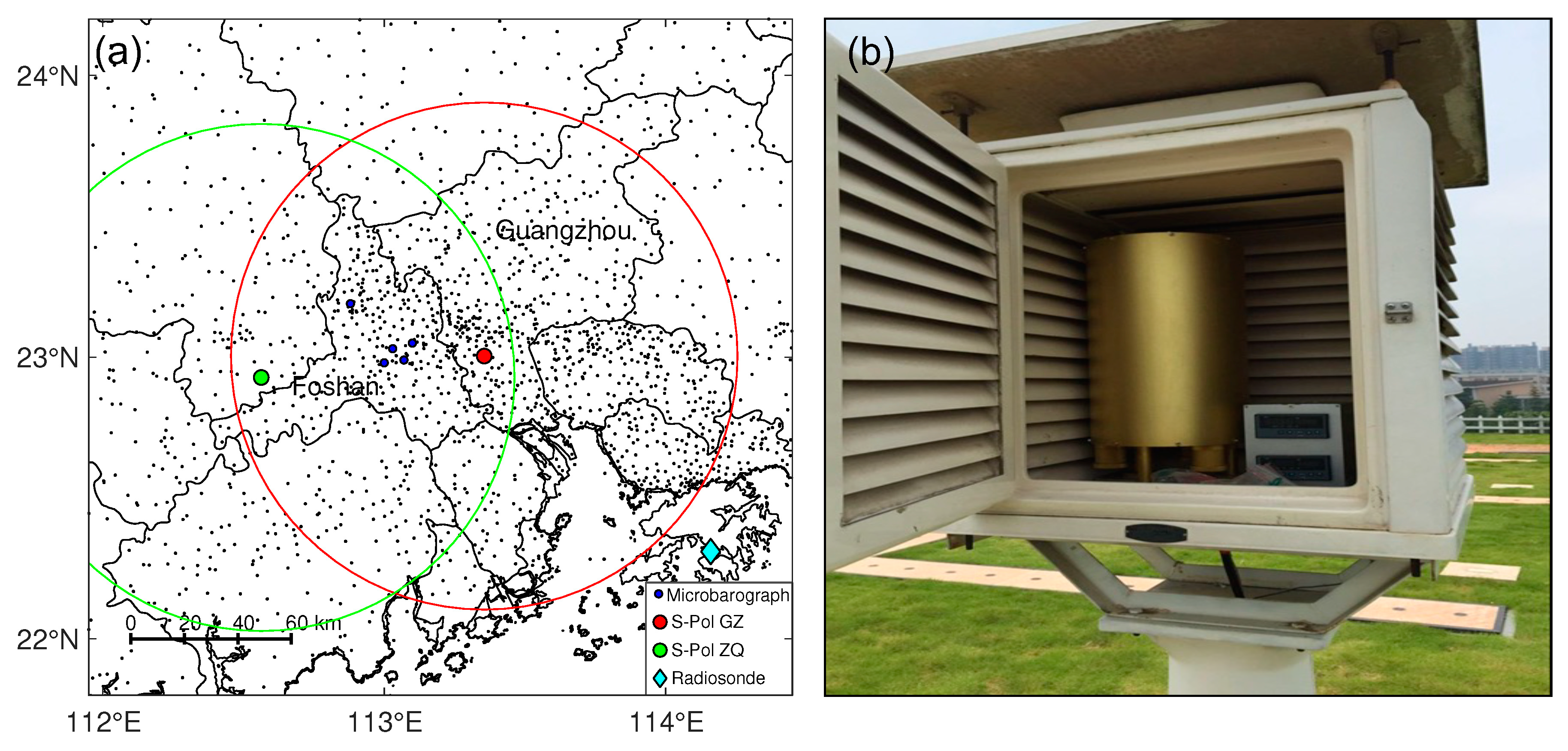
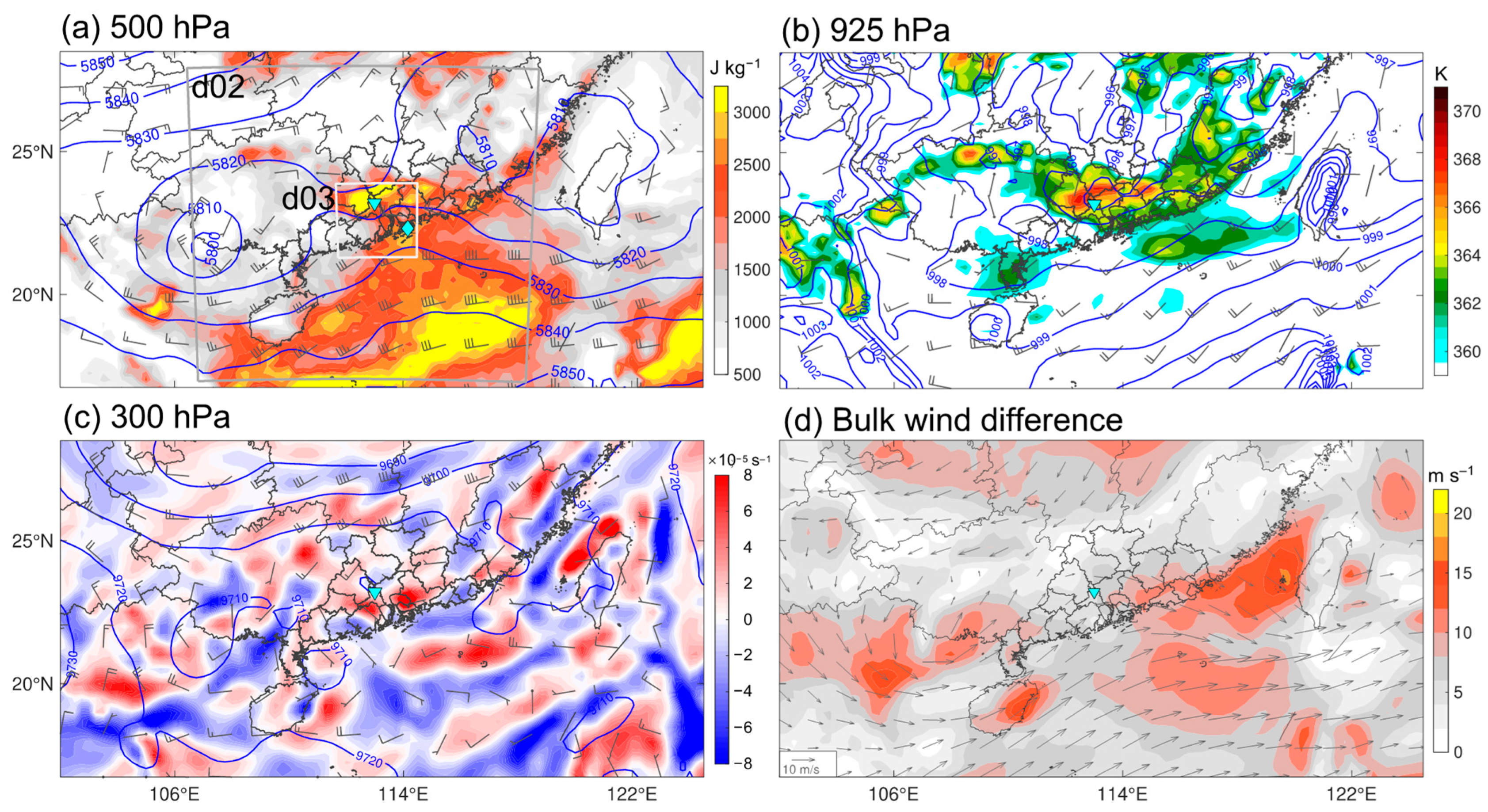

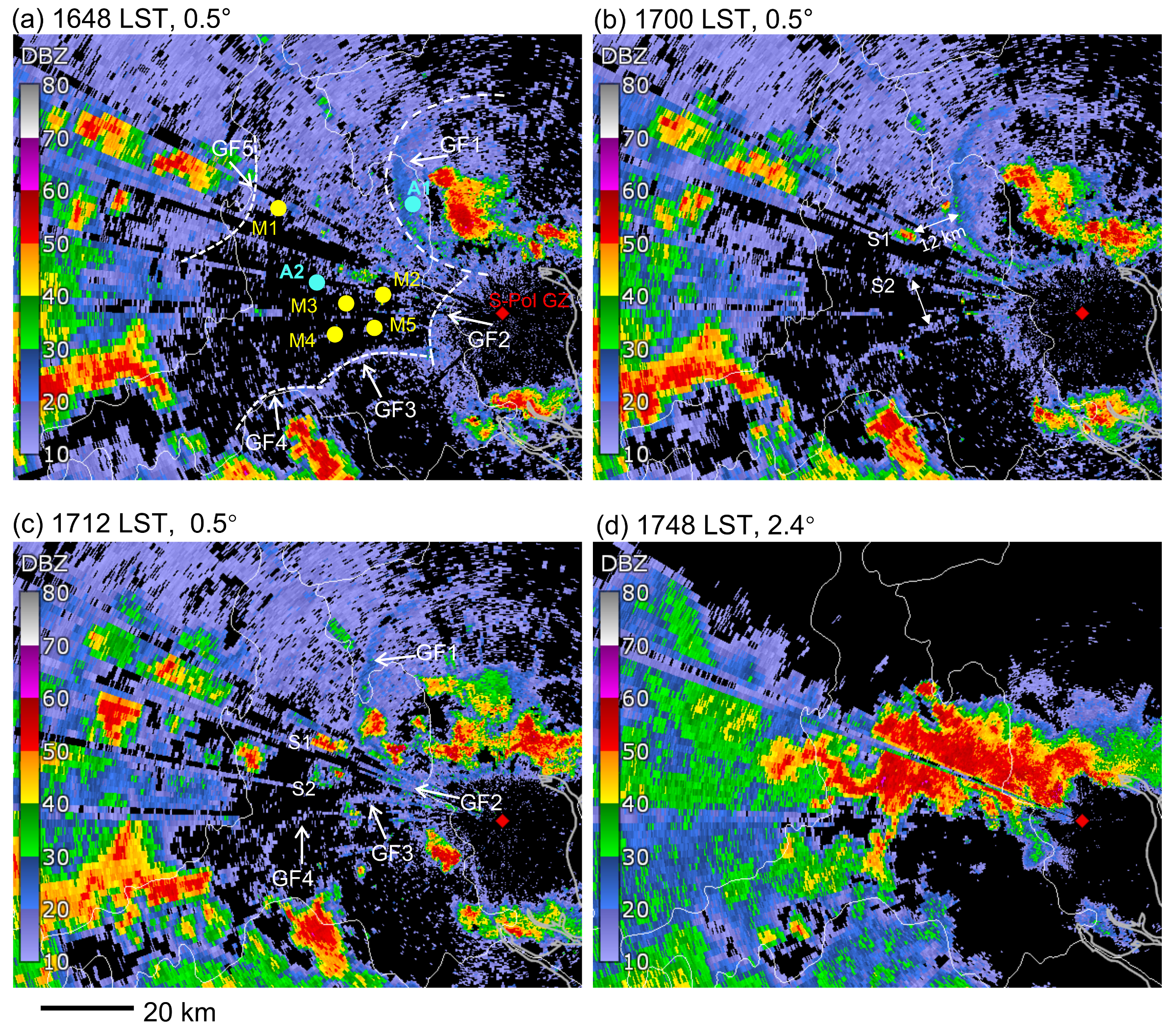
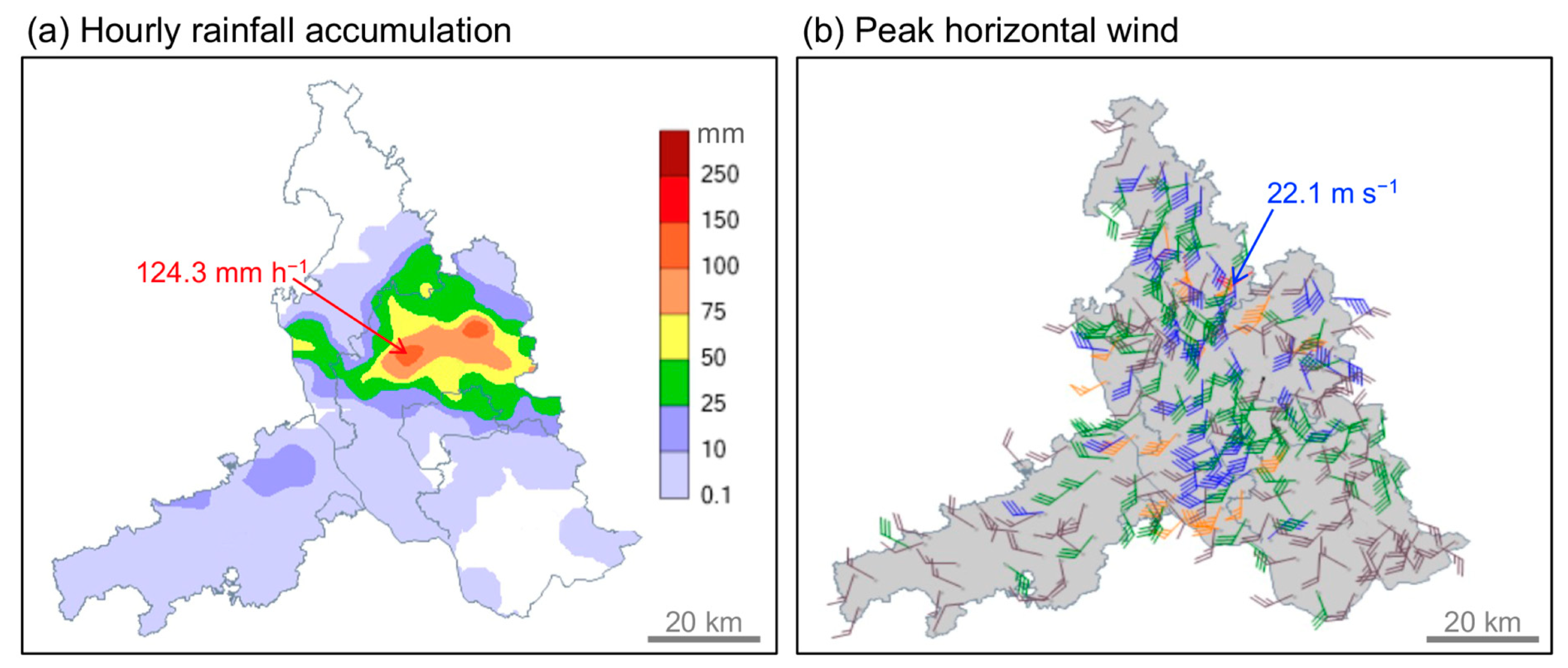
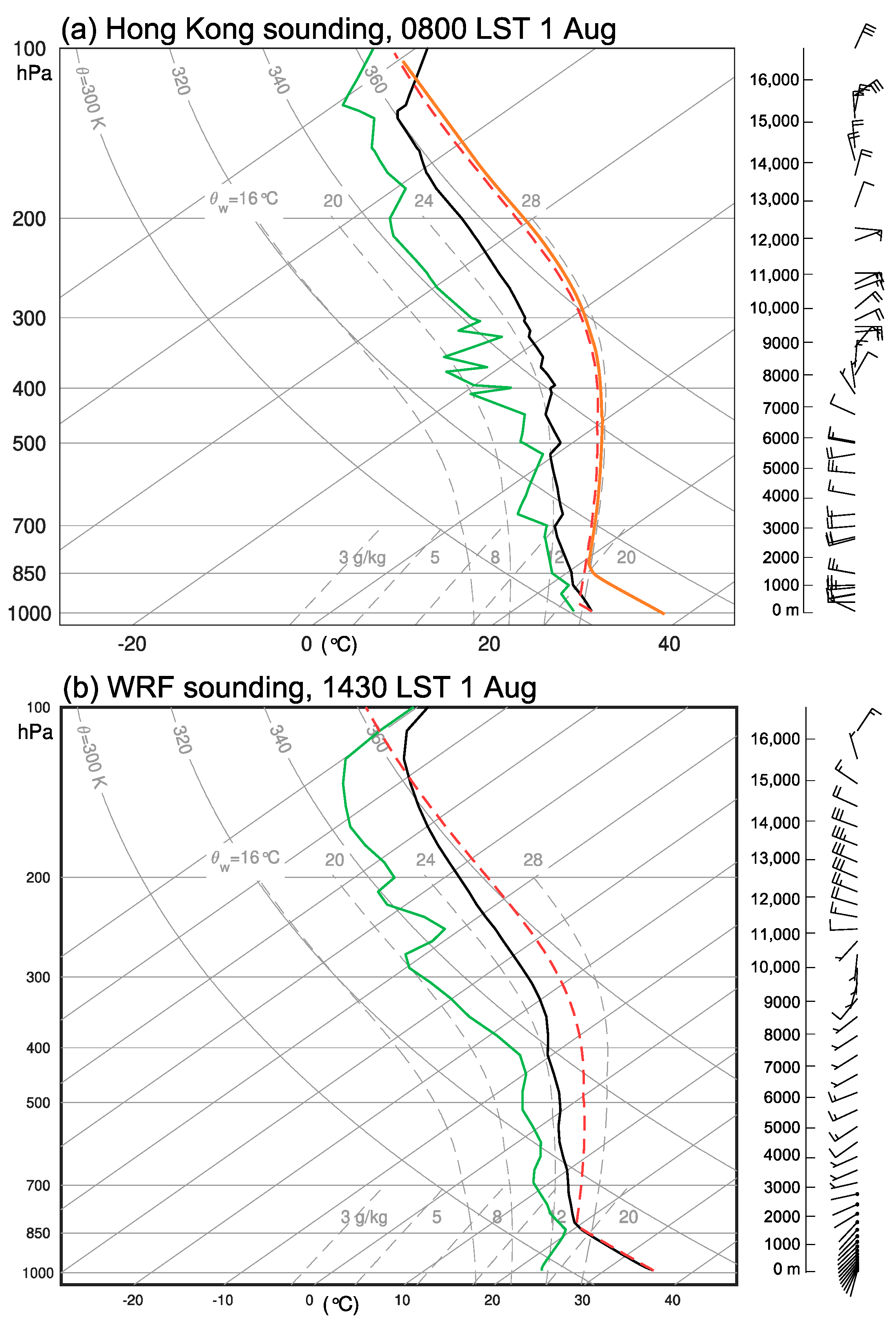
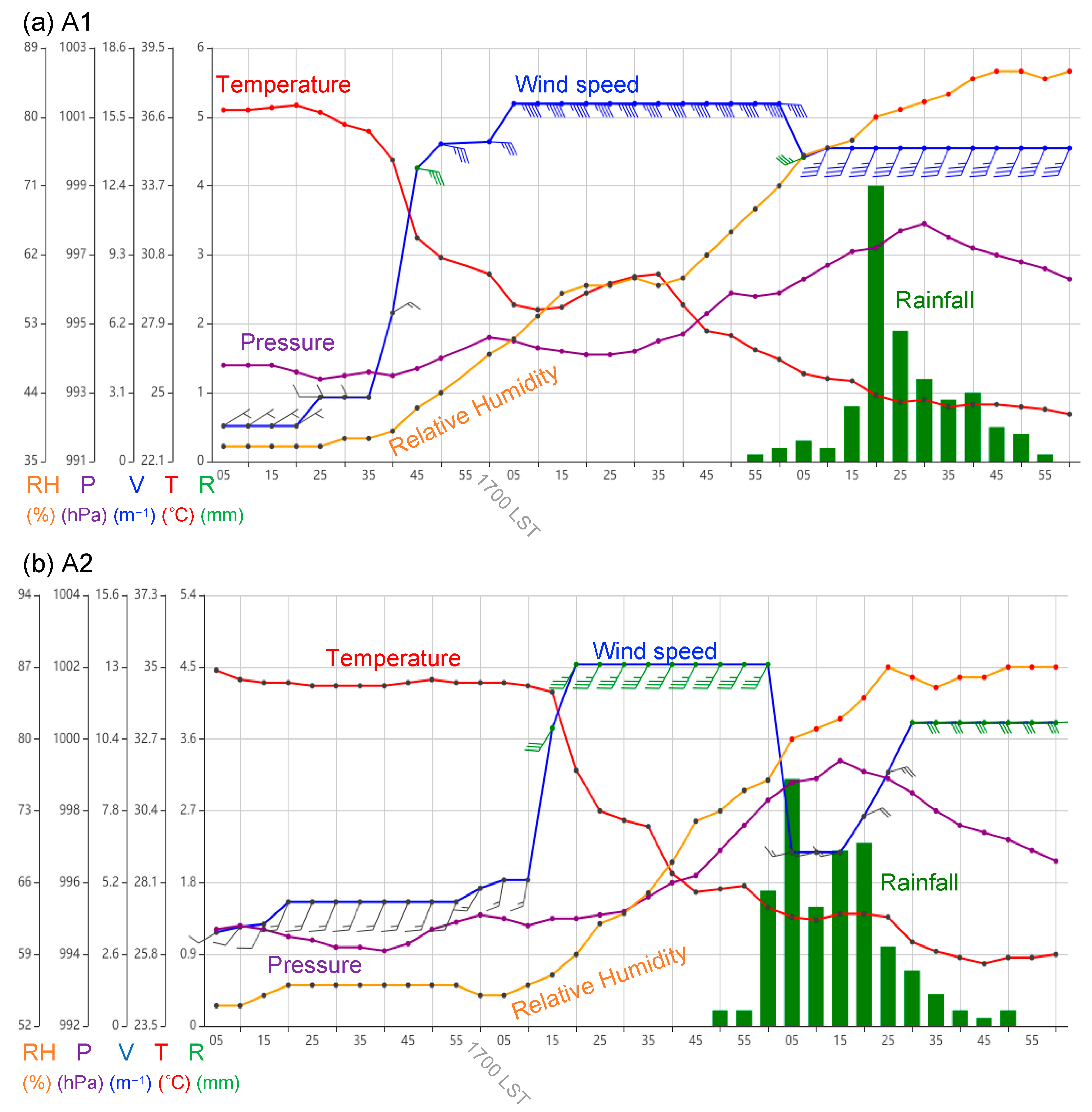

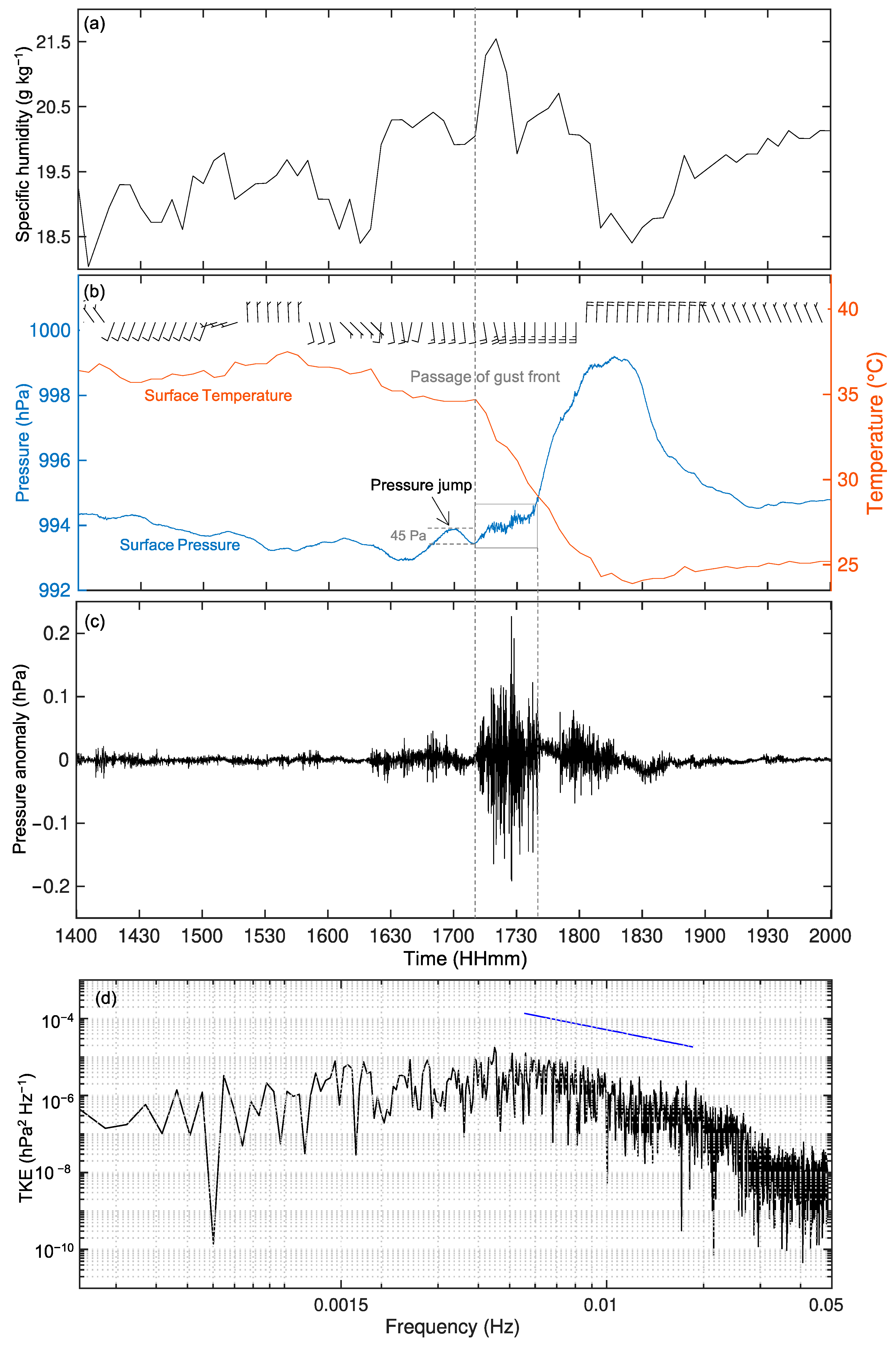

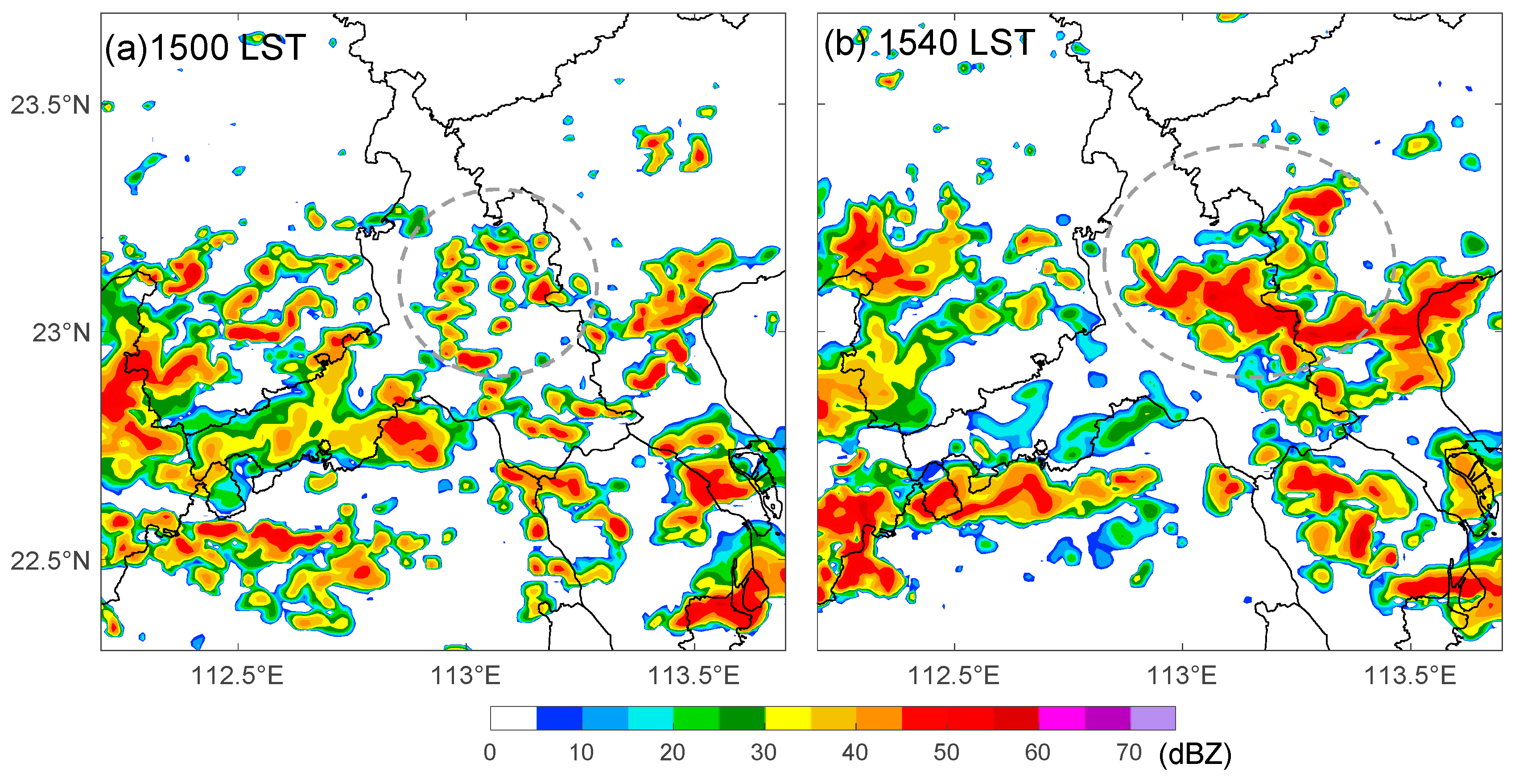


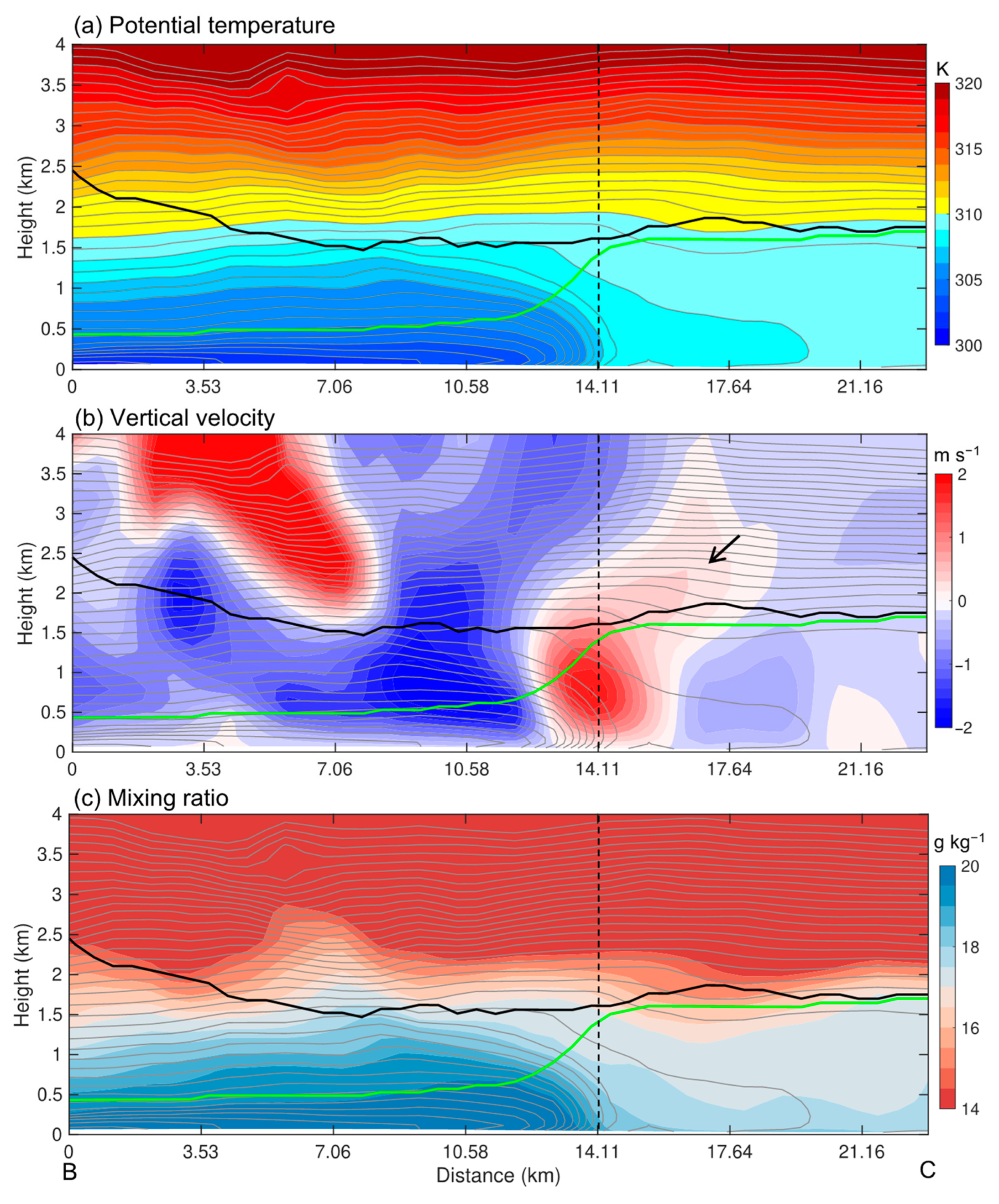
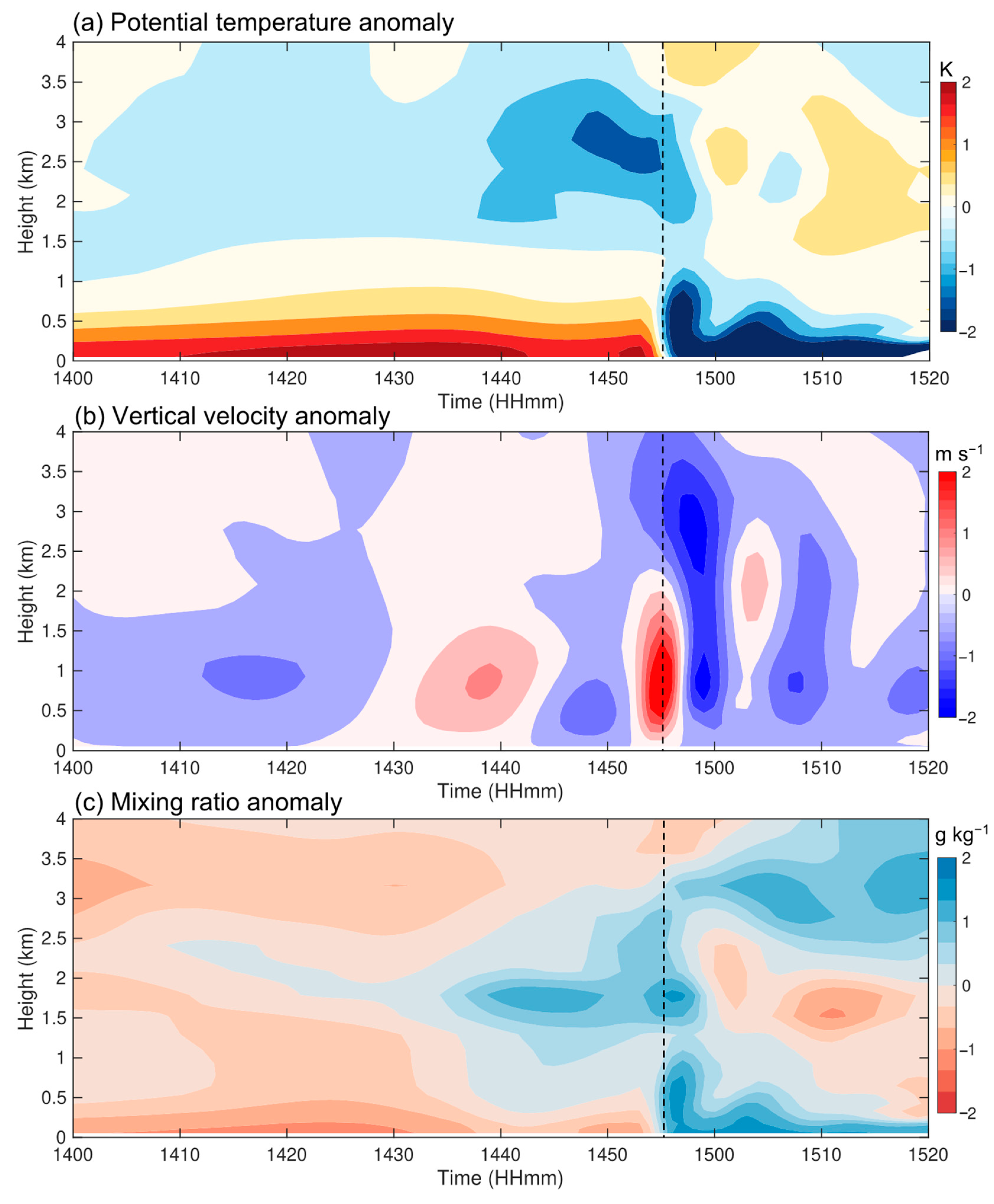
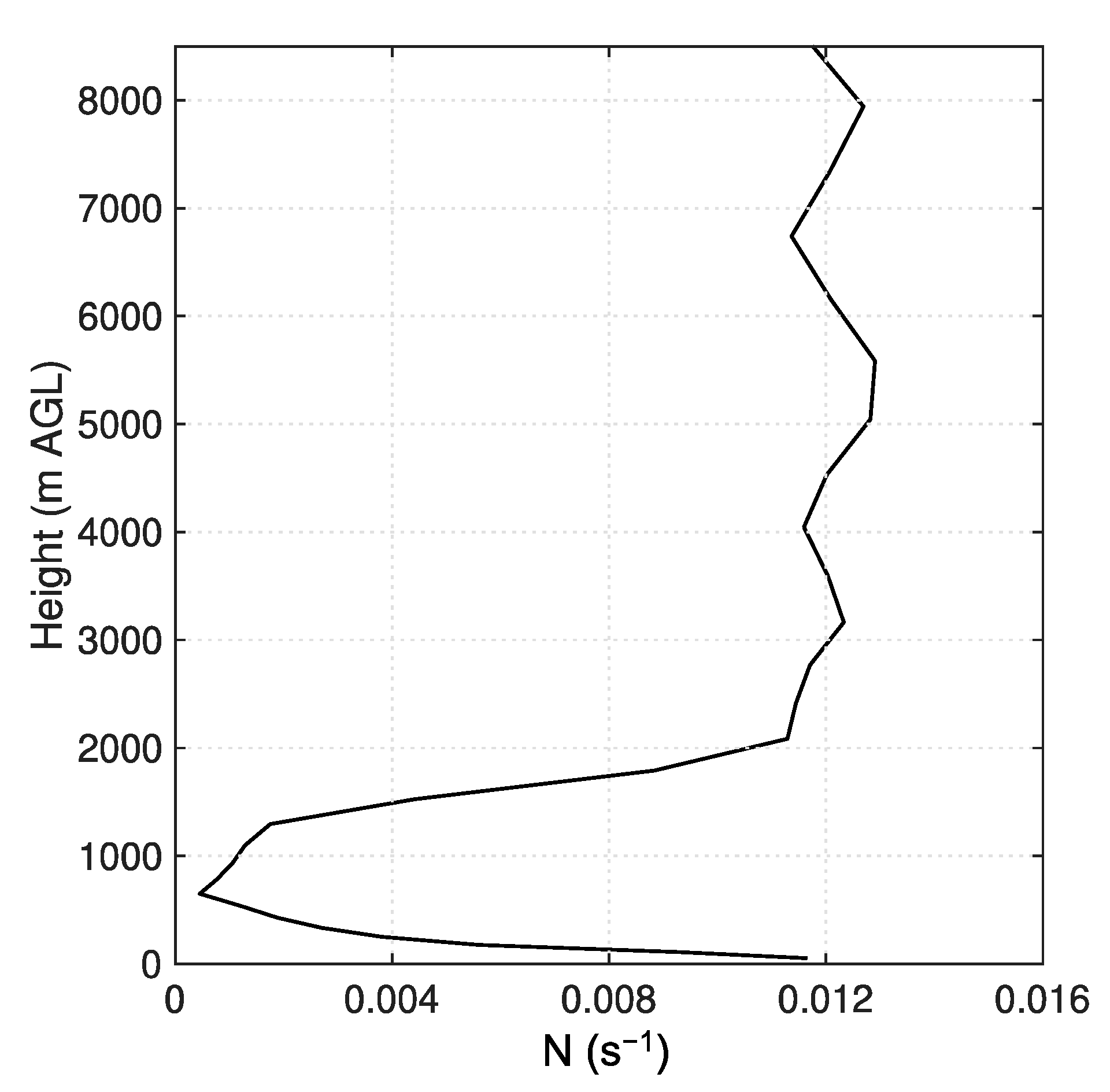
Disclaimer/Publisher’s Note: The statements, opinions and data contained in all publications are solely those of the individual author(s) and contributor(s) and not of MDPI and/or the editor(s). MDPI and/or the editor(s) disclaim responsibility for any injury to people or property resulting from any ideas, methods, instructions or products referred to in the content. |
© 2023 by the authors. Licensee MDPI, Basel, Switzerland. This article is an open access article distributed under the terms and conditions of the Creative Commons Attribution (CC BY) license (https://creativecommons.org/licenses/by/4.0/).
Share and Cite
Zhang, J.; Bai, L.; Li, Z.; Du, Y.; Zhang, S. High-Frequency Microbarograph-Observed Pressure Variations Associated with Gust Fronts during an Extreme Rainfall Event. Remote Sens. 2024, 16, 101. https://doi.org/10.3390/rs16010101
Zhang J, Bai L, Li Z, Du Y, Zhang S. High-Frequency Microbarograph-Observed Pressure Variations Associated with Gust Fronts during an Extreme Rainfall Event. Remote Sensing. 2024; 16(1):101. https://doi.org/10.3390/rs16010101
Chicago/Turabian StyleZhang, Jingjing, Lanqiang Bai, Zhaoming Li, Yu Du, and Shushi Zhang. 2024. "High-Frequency Microbarograph-Observed Pressure Variations Associated with Gust Fronts during an Extreme Rainfall Event" Remote Sensing 16, no. 1: 101. https://doi.org/10.3390/rs16010101
APA StyleZhang, J., Bai, L., Li, Z., Du, Y., & Zhang, S. (2024). High-Frequency Microbarograph-Observed Pressure Variations Associated with Gust Fronts during an Extreme Rainfall Event. Remote Sensing, 16(1), 101. https://doi.org/10.3390/rs16010101







